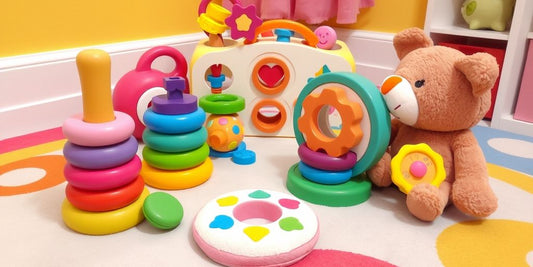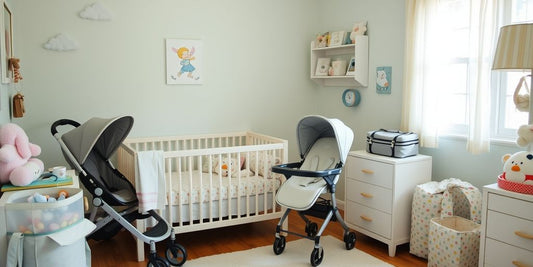Designing a play area for your baby is a wonderful way to support their growth and learning. This special space should be safe, fun, and full of things that stimulate your baby's mind and senses. In this article, we will provide you with easy tips to create a play area that is perfect for your little one.
Key Takeaways
- Choose a quiet and calm location close to caregivers for the play area.
- Ensure the play space is baby-proofed and uses non-toxic materials.
- Select toys that are suitable for your baby's age to promote sensory and educational development.
- Incorporate elements like colors, textures, and sounds to make the play area stimulating.
- Regularly update the play area to match your baby's growing needs and ensure continued safety.
Choosing the Right Location for the Play Area

Creating a safe and fun play area for your baby starts with picking the right spot. Choosing the right location is crucial for your baby's overall development and wellbeing.
Ensuring Safety in the Play Area
Creating a safe play area for your baby is crucial. By following some essential safety measures, you can ensure your child has a secure place to explore and play without the risk of injury.
Selecting Age-Appropriate Toys and Materials

Choosing the right toys and materials for your baby is crucial for their development and safety. It's important to match toys with your child's age and developmental stage. This ensures they are both engaging and safe for your little one.
Incorporating Stimulating Elements
Creating a play area that stimulates your baby's senses is essential for their development. Incorporate bright colors and visual elements to catch their attention and keep them engaged. Babies are naturally drawn to vibrant colors, which can stimulate their developing senses.
Using Color and Light
Use a variety of colors and lighting to create a visually stimulating environment. Soft, warm lights can create a calming atmosphere, while brighter lights can make the space more exciting. Consider using night lights or lamps that project shapes or stars on the ceiling.
Introducing Different Textures
Incorporate a range of textures in the play area to help your baby explore and learn. Soft rugs, textured mats, and plush toys can provide a tactile experience that is both fun and educational. Babies love to touch and feel different surfaces, which helps them develop their sense of touch.
Incorporating Music and Sounds
Music and sounds can greatly enhance your baby's playtime. Use toys that make gentle sounds or play soft music in the background. This can help soothe your baby and make the play area more enjoyable. Consider using a variety of sounds, from nature sounds to lullabies, to keep things interesting.
Creating a Comfortable and Inviting Space
Choosing Soft Furnishings
To make the play area cozy, use soft furnishings like bean bag chairs, cushions, and plush rugs. These items not only provide comfort but also create a welcoming atmosphere for your baby. Soft seating options are perfect for relaxing and playing.
Maintaining Cleanliness
Keeping the play area clean is essential for your baby's health. Regularly wash toys, cushions, and other items to prevent the buildup of germs. A clean space ensures that your baby can play safely and happily.
Personalizing the Space
Add personal touches to the play area to make it special. You can include colorful posters, artwork, and other visual materials. This not only makes the space more inviting but also stimulates your baby's senses. Rearranging furniture can create more open areas for your baby to explore.
Adapting the Play Area as Your Baby Grows
As your baby grows, their play area should evolve to meet their changing needs. Adapting the play area ensures that it remains a safe and engaging space for your child.
Conclusion
Creating a safe and stimulating play area for your baby is a rewarding task that greatly contributes to their growth and happiness. By carefully planning and using your creativity, you can design a space that is both secure and engaging. Remember to choose a suitable location, ensure safety, and include a variety of toys and activities to keep your baby interested. The best play area is one where your baby feels happy, secure, and curious. With these tips, you can create a wonderful environment that supports your baby's development and joy.
Frequently Asked Questions
How do I choose the best location for my baby's play area?
Pick a spot where you can easily watch your baby. Make sure it's calm and free from noise. The area should also have enough space for your baby to move around safely.
What safety measures should I take in the play area?
Baby-proof the area by covering sharp edges and removing small objects that could be choking hazards. Use non-toxic materials and check the space regularly for any safety issues.
What types of toys are best for my baby's development?
Choose toys that help with sensory development, like soft blocks and rattles. Interactive toys that make sounds or light up can also be great for learning.
How can I keep my baby interested in the play area?
Rotate toys every few weeks to keep things fresh. Introduce new textures, colors, and sounds to keep your baby engaged and curious.
What should I include to make the play area comfortable?
Use soft furnishings like padded mats and cushions. Keep the area clean and add personal touches like family photos or your baby's favorite blanket.
How do I adapt the play area as my baby grows?
As your baby starts to move, make sure the area is safe for crawling and walking. Add new toys and challenges to keep up with their development.









